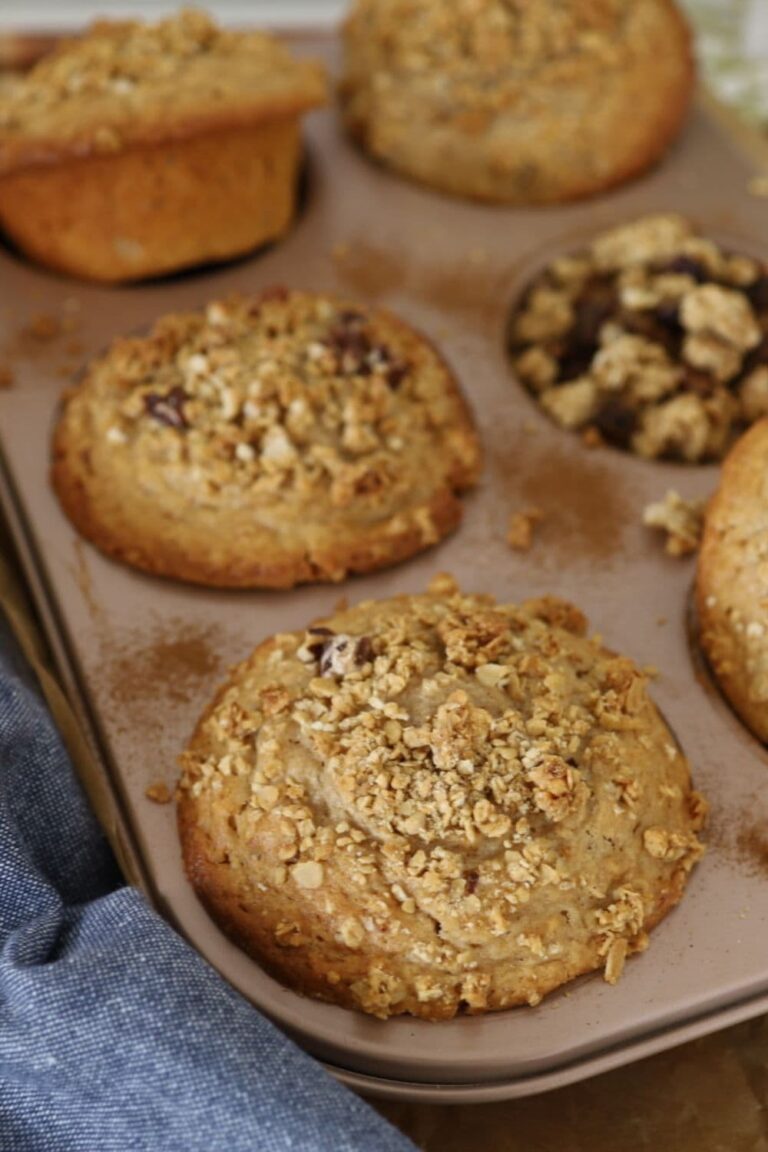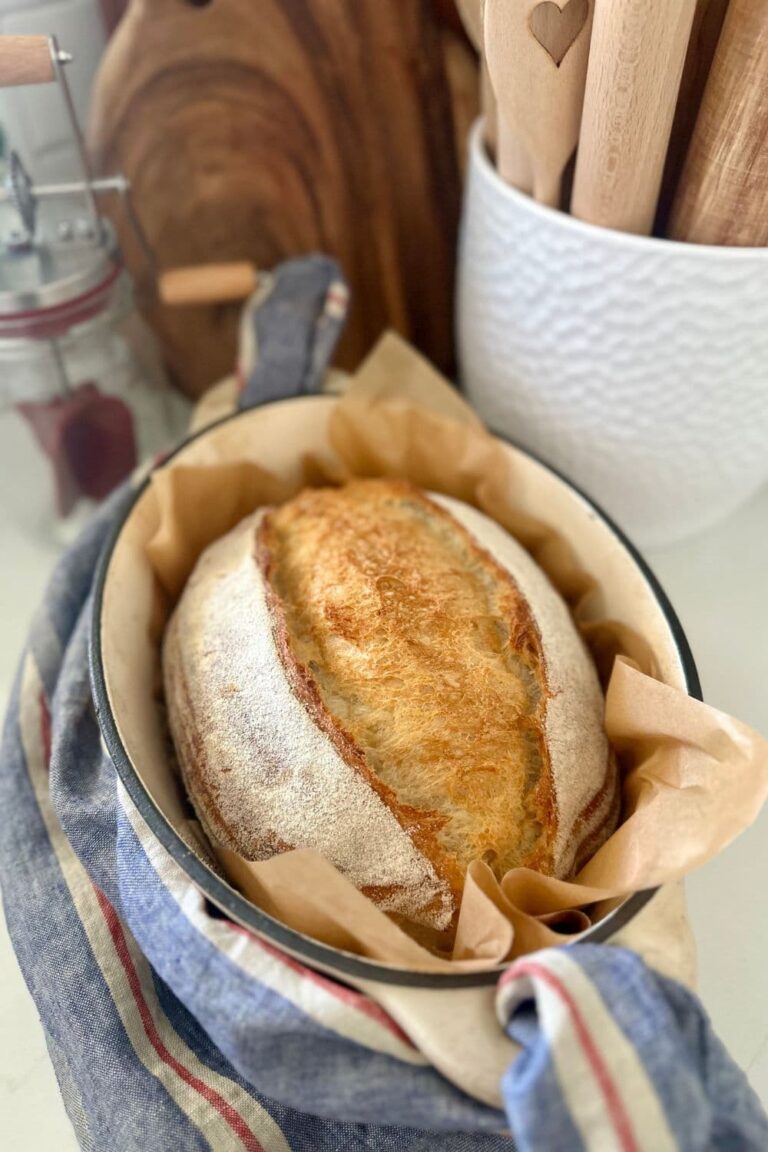Walnut Raisin Sourdough Bread
This post may contain affiliate links.
If you love fruit and nut bread, then you are going to love this walnut raisin sourdough bread. It's full of crunchy walnuts and juicy raisins guaranteed to tempt your tastebuds!
This sourdough bread uses your active sourdough starter - make sure it's been fed in the last few hours and is bubbly and at its peak. This will ensure you get a lovely open, lacy crumb and a crispy, crunchy sourdough crust.
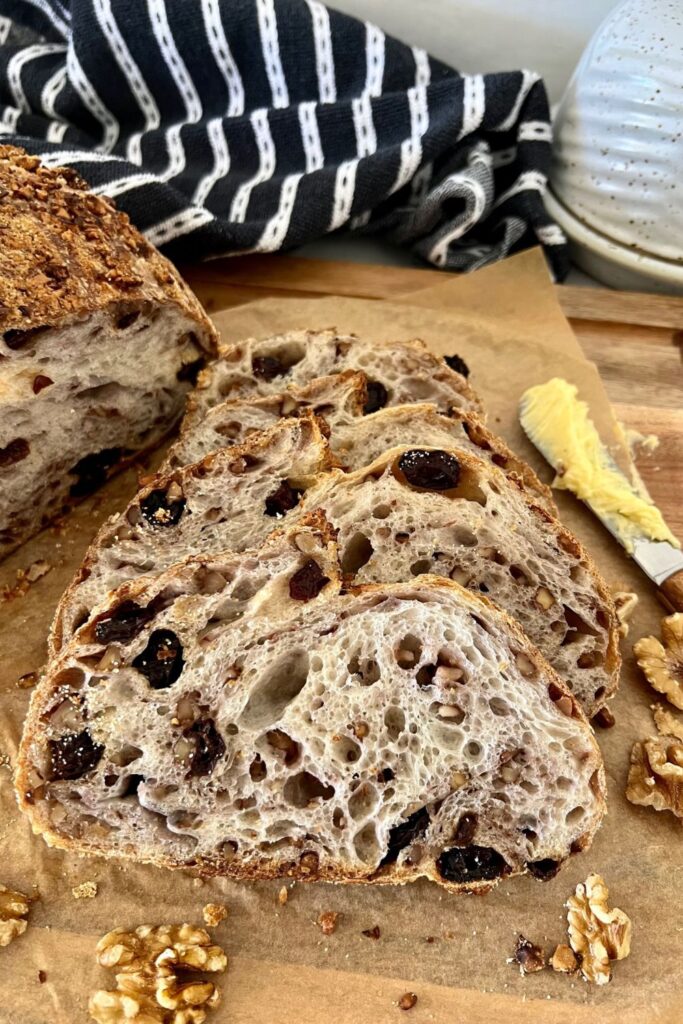
This walnut raisin sourdough bread makes the perfect breakfast toast and can even be turned into sourdough French Toast or sourdough bread pudding (if there's any left). It's like the fruit bread you love, only more grown up!
And if you love all things sourdough, make sure you try this sourdough fruit bread, sourdough oatmeal raisin muffins and this sourdough oatmeal loaf too! Just like this sourdough walnut raisin bread, these are also lovely enjoyed with homemade butter or even cultured butter.
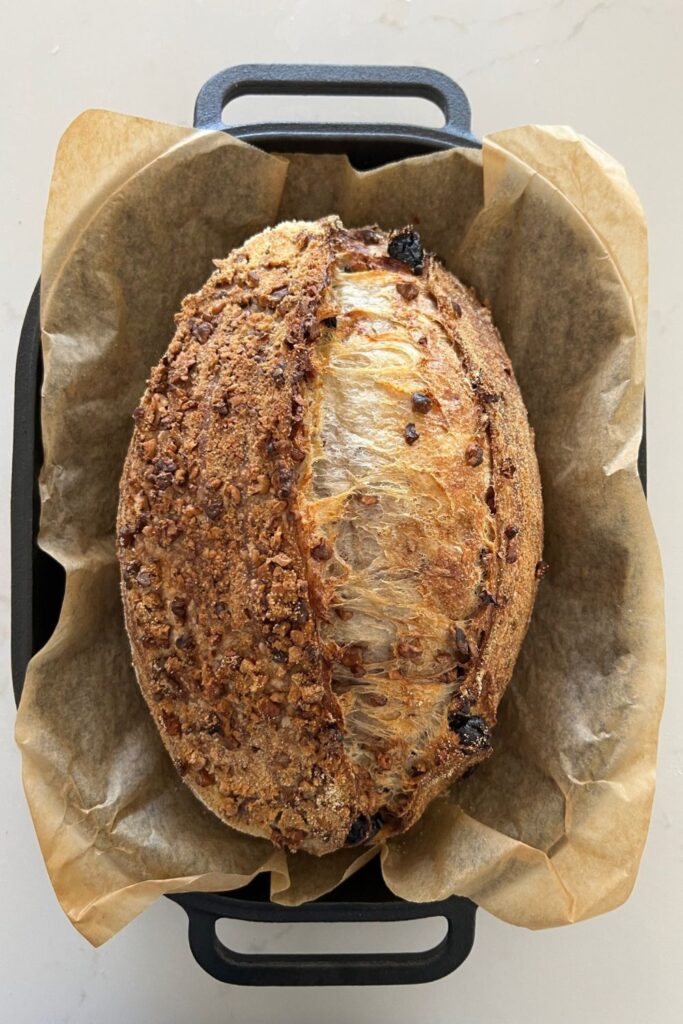
How To Make Walnut Raisin Sourdough Bread
This simple, yet tasty sourdough flavor combination is based on my basic sourdough bread recipe. You can choose to laminate the raisins and walnuts, or add them during the stretch and fold phase if you prefer.
I find laminating them makes them more evenly distributed and gives me a lacier crumb in this loaf.
Here's how to make it!
Autolyse - Premixing The Dough
Weigh out your sourdough starter and water into a large ceramic or glass bowl.
This recipe is based on you having an active sourdough starter that you have fed a few hours before starting your bake.
Mix the water and starter together briefly. Then add your flour and salt and mix whole lot together to form a shaggy dough.
Cover your bowl with cling film or a damp tea towel and let it sit for around 1 hour.
This process is called the "autolyse" and allows your flour to soak in all the water and become hydrated.
Forming Up The Dough
After the dough has been through autolyse you need to bring it together into a ball. Work your way around the bowl, grabbing the dough from the outside, stretching it up and over itself, into the centre, until a smooth ball is formed. You shouldn't need more than about 20-30 stretches to form the ball.
You'll notice that the dough is fully hydrated after soaking all the water up. It will be fairly sticky but as you bring it into a ball, it will become smoother and shinier.
Once the dough has formed into a smooth ball, pop the cling film back on and let it rest for 30 minutes.
Stretch & Fold - Creating Structure
Over the next few hours you need to create some structure for your dough by "stretching and folding".
Aim to do around 4 sets of stretches and folds.
For each set, stretch the dough up and over itself 4 times. Leave around 15 minutes in between each set. Again you do not have to be exact with time, but you need to do 4 sets over 2 hours.
**If you don't want to laminate the walnuts and raisins in the step below, see notes for how to add them during stretch and folds**
Lamination of Walnuts and Raisins
Once your dough is nice and elastic, spray your counter with water and pop the dough out of the bowl.
Gently stretch the dough out so that it forms a rough square - it doesn't have to be exact.If you've never laminated dough before, check out these detailed instructions.
Sprinkle the walnuts and raisins evenly over the dough and then roll it up into a log and place back into the bowl for bulk ferment.
If you don't want to laminate the walnuts and raisins, see notes for how to add them during the stretching and folding stage.
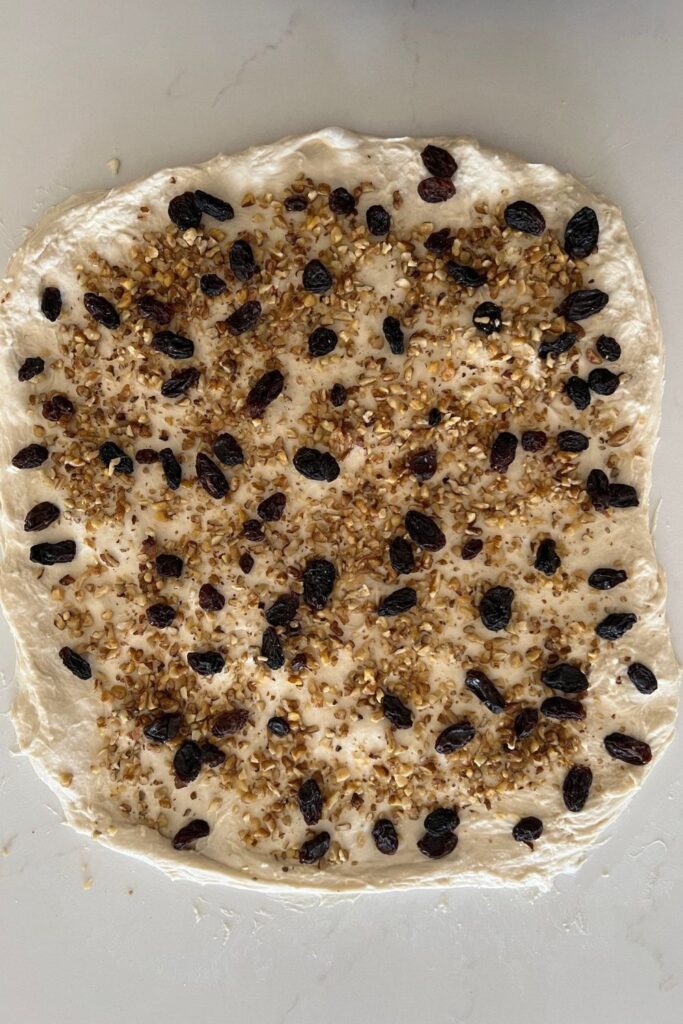
Bulk Ferment
Once you've finished your stretch and folds, place the cling film or damp tea towel back over your dough and let it rest and ferment (a plastic cover is a better option for this stage).
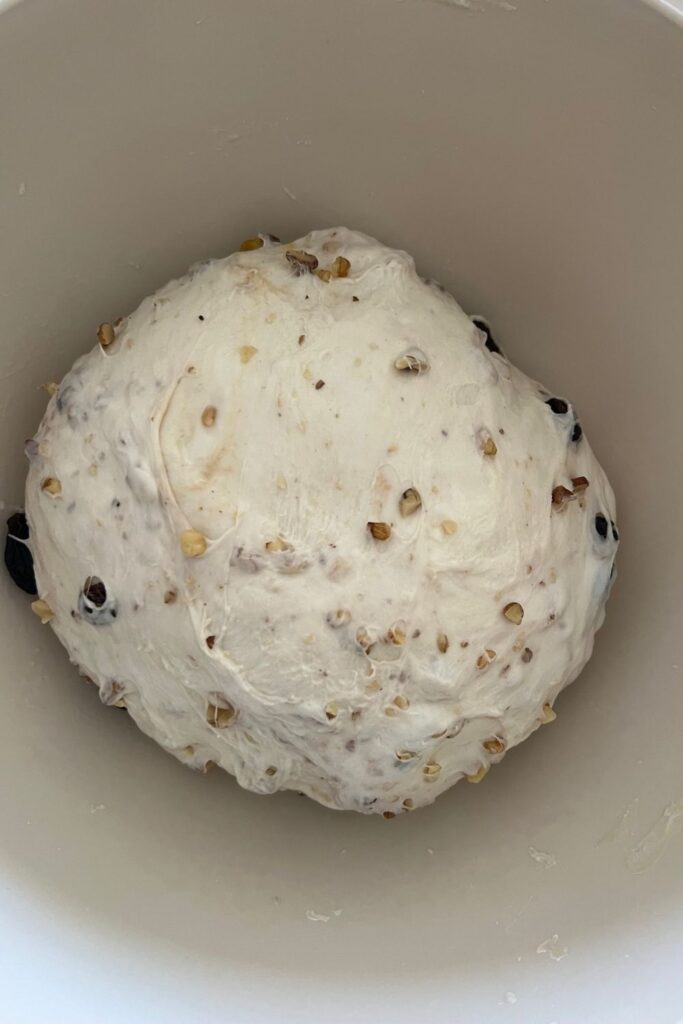
Shaping The Dough
Once your dough has finished its bulk ferment, it's time to shape it into either a boule or a batard (you can see my easy shaping method here).
You will need a banneton to put your dough into. If you do not have a banneton, then a bowl or basket lined with a floured tea towel is perfectly fine (see other alternatives here).
Make sure your bowl isn't too big though, you want your dough to retain some shape.
Placing Dough Into The Banneton
Liberally dust your banneton with rice flour to stop it sticking (if you want to add walnuts to the top of the dough, do not use rice flour. Place the walnuts in the banneton before you place the dough on top).
Place the shaped dough into your banneton smooth side down, so your seam is on the top - this way the top of your dough will get the pretty lines from the banneton.
If you are worried about the dough sticking, you can also add a bit of rice flour around the sides of the dough too, just carefully lift the dough gently with your fingers (you can do this even if you've used walnuts in the bottom).
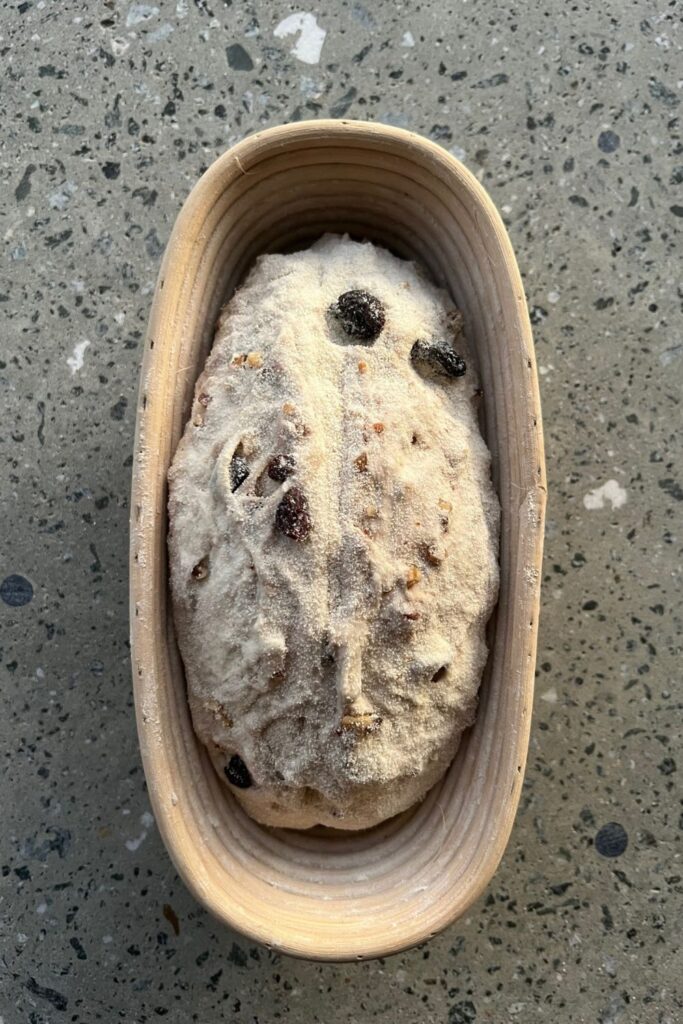
Cold Ferment
Now the dough is in its "shaping container" cover it loosely with a plastic bag or damp tea towel and place into the fridge.
Try to leave it in the fridge for a minimum 5 hours.
Preparing To Bake
Once you're ready to bake your sourdough, you'll need to preheat your oven to 230C/450F.
Place your Dutch Oven into the oven when you turn it on so it gets HOT. Try to preheat for around 1 hour to ensure your oven is super hot - but you know your oven so just adjust this time if you need to.
Leave your dough in the fridge until the very last minute - placing a cold dough into a hot oven will give you a great oven spring.
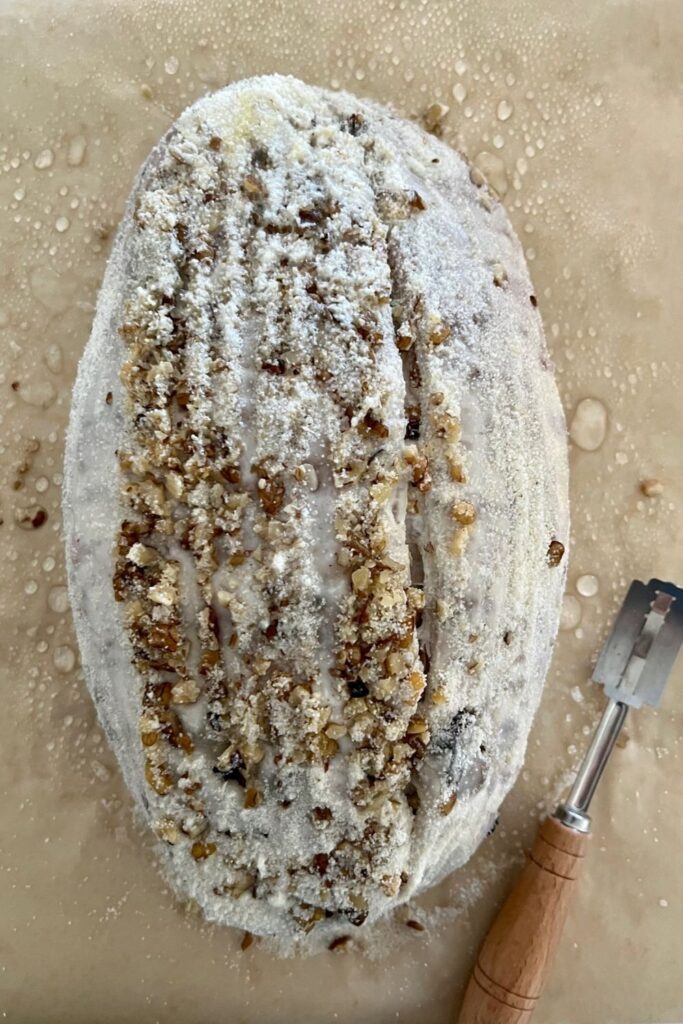
Bake Time!
Now it's time to bake!
When your oven is at temperature, take your sourdough out of the fridge. Gently place it onto a piece of baking paper.
Make sure that you make the baking paper big enough to use the edges as a handle to lower to dough into your Dutch Oven.
Gently score your bread with a lame, clean razor blade or knife. I find a single slash is best for this recipe as the walnuts can be tricky to cut through. You can find my full guide on how to score sourdough bread here.
Carefully take your dutch oven out of the oven. Place the sourdough into the pot using the baking paper as a handle. Put the lid on and place into the hot oven.
If you want to you can spritz your dough with extra water before you put the lid on.
BAKE TIME:
30 Minutes with the lid on at 230C/450F plus
10-15 Minutes with the lid off at 210C/410F
Finishing The Bake
When you remove your dough from the oven, carefully remove it from the dutch oven as soon as possible and place on a wire rack to cool.
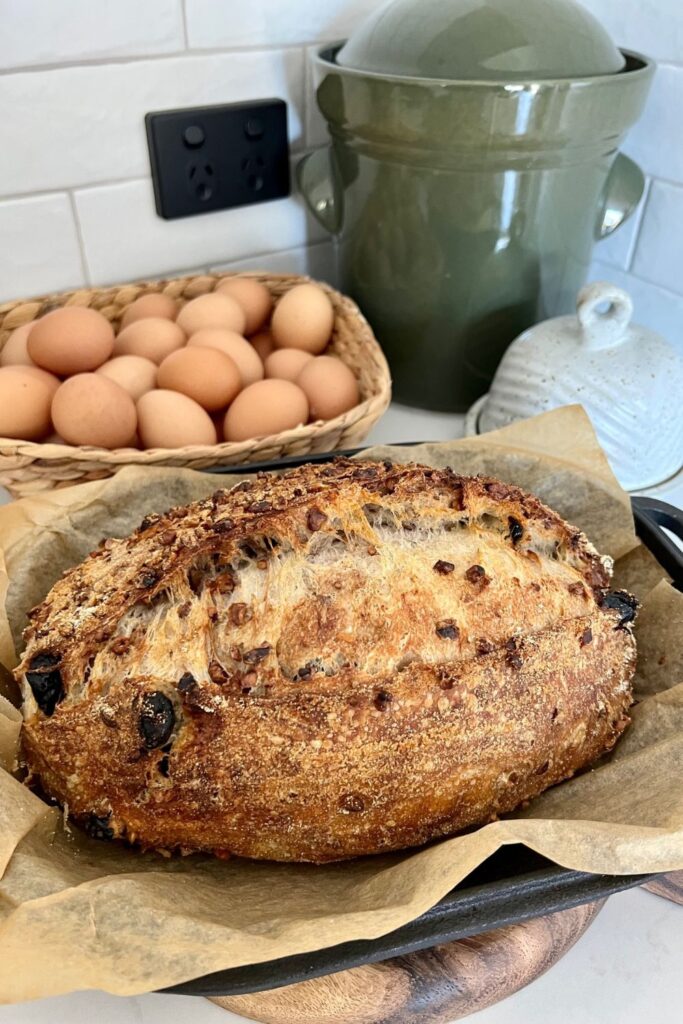
Do I Need To Soak The Raisins?
No, you do not need to soak the raisins for this loaf. This recipe has a slightly higher amount of water to account for the raisins soaking up some of it in the dough.
Of course, if you want to, you certainly can. However I have successfully made this loaf without soaking the raisins at all.
If you do choose to soak them, ensure you drain them really well before adding them to your dough or you will increase the hydration too much.
Can I Use Whole Wheat Flour For This Recipe?
Yes you can add up to 250g of whole wheat flour in this recipe (instead of using all bread flour). This will give you more of a "country sourdough loaf".
I recommend adding a little vital wheat gluten to the flour if you are going to use some whole wheat as the walnuts and raisins are very heavy and can make the crumb too dense when using whole wheat.
Can I Change The Nuts For Something Different?
You can definitely use different nuts if you prefer. Chopped almonds, pistachios or even macadamia nuts are lovely substitutes.
Can I Add Cinnamon To This Sourdough Recipe?
Cinnamon is delicious, however it can inhibit fermentation in wild yeast. I don't recommend adding cinnamon to this loaf but instead enjoy it spread with this whipped cinnamon honey butter!
Storing + Freezing
Like most sourdough, this loaf is best eaten within 12 hours of baking. While it is still ok for 3 - 5 days afterwards, it's better toasted after the initial period of baking. You can read more about how to store sourdough and how long sourdough lasts for here.
This loaf is suitable for freezing. You will find instructions for freezing and reheating/serving here.
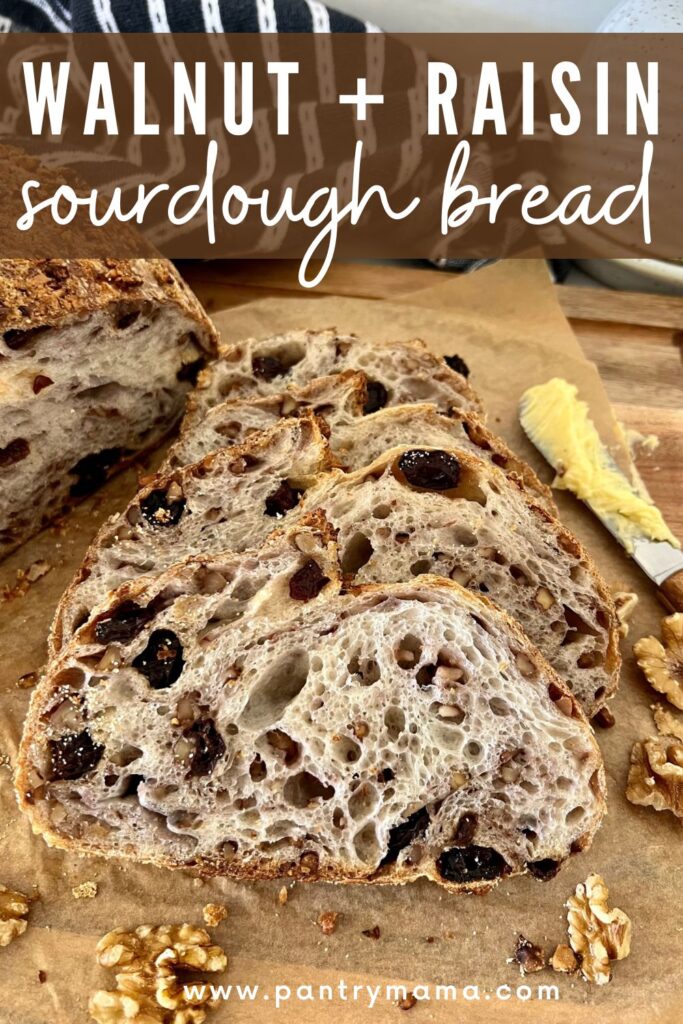

Walnut Raisin Sourdough Bread
Equipment
- Mixing Bowl
- Digital Scales
- Banneton
- Dutch Oven optional
Ingredients
- 500 g Bread Flour
- 360 g Water
- 50 g Sourdough Starter (fed and bubbly)
- 10 g Salt
- 100 g Walnuts (roughly chopped)
- 100 g Raisins (or sultanas if you prefer)
Instructions
- Autolyse - Premixing The DoughWeigh out your sourdough starter and water into a large ceramic or glass bowl. Glass is always good as you can see what's happening underneath your dough. This recipe is based on you having an active starter that you have fed a few hours before starting your bake.Mix the water and starter together briefly. Then add your flour and salt and mix whole lot together to form a shaggy dough. The dough will be fairly shaggy and only just brought together.
- Cover your bowl with cling film or a damp tea towel and let it sit for around 1 hour. It's ok if it's a little bit longer, it's not going to matter too much.This process is called the "autolyse" and allows your flour to soak in all the water and become hydrated.
- Forming Up The DoughAfter the dough has been through autolyse you need to bring it together into a ball. Work your way around the bowl, grabbing the dough from the outside, stretching it up and over itself, into the centre, until a smooth ball is formed. You shouldn't need more than about 20-30 stretches to form the ball. You'll notice that the dough is fully hydrated after soaking all the water up. It will be fairly sticky but as you bring it into a ball, it will become smoother and shinier.
- Once the dough has formed into a smooth ball, pop the cling film back on and let it rest for 30 minutes.
- Stretch & Fold - Creating StructureOver the next few hours you need to create some structure for your dough by "stretching and folding". Aim to do around 4 sets of stretches and folds. For each set, stretch the dough up and over itself 4 times. Leave around 15 minutes in between each set. Again you do not have to be exact with time, but you need to do 4 sets over 2 hours.If you don't want to laminate the walnuts and raisins in the step below, see notes for how to add them during stretch and folds.
- Lamination of Walnuts and RaisinsOnce your dough is nice and elastic, spray your counter with water and pop the dough out of the bowl. Gently stretch the dough out so that it forms a rough square - it doesn't have to be exact. If you've never laminated dough before, check out these detailed instructions.Sprinkle the walnuts and raisins evenly over the dough and then roll it up into a log and place back into the bowl for bulk ferment.If you don't want to laminate the walnuts and raisins, see notes for how to add them during the stretching and folding stage.
- Bulk FermentOnce you've finished your stretch and folds, place the cling film or damp tea towel back over your dough and let it rest and ferment (a plastic cover is a better option for this stage).See notes below for more info on this step.
- Shaping The DoughOnce your dough has finished its bulk ferment, it's time to shape it into either a boule or a batard (see notes for more info).You will need a banneton to put your dough into. If you do not have a banneton, then a bowl or basket lined with a floured tea towel is perfectly fine. Make sure your bowl isn't too big though, you want your dough to retain some shape.
- Placing Dough Into The BannetonLiberally dust your banneton with rice flour to stop it sticking.Place the shaped dough into your banneton smooth side down, so your seam is on the top - this way the top of your dough will get the pretty lines from the banneton. If you are worried about the dough sticking, you can also add a bit of rice flour around the sides of the dough too, just carefully lift the dough gently with your fingers.
- Cold FermentNow the dough is in its "shaping container" cover it loosely with a plastic bag or damp tea towel and place into the fridge. I use a large plastic bag to cover it - I just reuse it each time. Try to leave it in the fridge for a minimum 5 hours.
- Preparing To BakeOnce you're ready to bake your sourdough, you'll need to preheat your oven to 230C/450F. Place your Dutch Oven into the oven when you turn it on so it gets HOT. Try to preheat for around 1 hour to ensure your oven is super hot - but you know your oven so just adjust this time if you need to.Leave your dough in the fridge until the very last minute - placing a cold dough into a hot oven will give you a great "spring".
- Bake Time!Now it's time to bake!When your oven is at temperature, take your sourdough out of the fridge. Gently place it onto a piece of baking paper. Make sure that you make the baking paper big enough to use the edges as a handle to lower to dough into your Dutch Oven.Gently score your bread with a lame, clean razor blade or knife. I find a single slash is best for this recipe as the walnuts can be tricky to cut through. You can find my full guide on how to score sourdough bread here.Carefully take your dutch oven out of the oven. Place the sourdough into the pot using the baking paper as a handle. Put the lid on and place into the hot oven. If you want to you can spritz your dough with extra water before you put the lid on.BAKE TIME:30 Minutes with the lid on at 230C/450F plus10-15 Minutes with the lid off at 210C/410F
- Finishing The BakeWhen you remove your dough from the oven, carefully remove it from the dutch oven as soon as possible and place on a wire rack to cool.
Notes
- Notes on Flour: This recipe is written using strong Bread Flour. Bread flour has a higher protein content than All Purpose flour. If you choose to use All Purpose flour you may have a different result because of this. You can read more about the differences between All Purpose Flour and Bread Flour here.
- Notes on Sourdough Starter: This recipe is based on you having an active starter that you have fed a few hours before starting your bake. For info on how to make a sourdough starter, go here.
- Adding Walnuts + Raisins - I've used dried raisins in this bread, but you can use sultanas if you can't get raisins. I have NOT soaked them at all before adding to the dough. I've used natural, unroasted walnuts that I've chopped up. If you don't want to laminate the walnuts and raisins, you can add them during the stretch and fold process. Add them around the second to third stretch and fold.
- Notes on Stretch & Folds: If you are going to do the stretch & folds on your bench top, spray your surface with water mist rather than using flour. You can leave the dough in the bowl if you want to. Wet your hands to stop the dough sticking - although it shouldn't be too sticky. It will get less sticky as you do your stretches and folds. For more information on how to do stretch and folds, go here.
- Notes on Bulk Fermentation: If your home is warm then your dough will ferment a lot faster and could be done in as little as a few hours. If it's colder, it will take longer, possibly overnight.
I would recommend that you try to do your first few bulk ferments during daylight hours so that you can watch your dough closely.
Once you're more familiar with the process - and the temperature of your home - you will be able to do overnight ferments. You will know your dough is ready to move to the next stage when it has *just* doubled in size. It will be fairly wobbly and full of bubbles. You should be able to see large air bubbles under the surface of the dough.
You don't want to let it go any further than doubled as it will be over fermented.
If you want to do an overnight ferment, but your home is warm, consider using a little less starter (ie 25g).
Less starter means your dough will take longer to ferment and you will reduce the risk of over fermenting your dough. You'll find more information on these topics here:
When is my bulk ferment finished? What is the difference between cold ferment and bulk ferment? Why does the amount of starter matter?
- Notes on Baking: If you're worried about the base of your bread burning, place a baking sheet on shelf underneath your Dutch Oven - it works! If you're worried about your bread not being cooked all the way through, turn the oven off and place your dough straight onto the oven rack. Leave the door ajar and let your bread rest there for a few hours. Make sure you don't close the door or your sourdough will sweat and you'll get a wrinkly, soggy crust. Remember not to cut into your loaf too soon - you'll need to let it cool for at least a few hours (4-6 is best).
Nutrition


